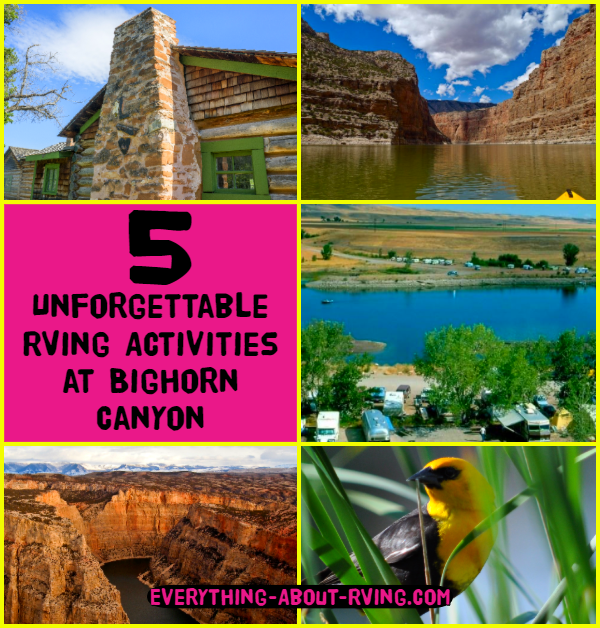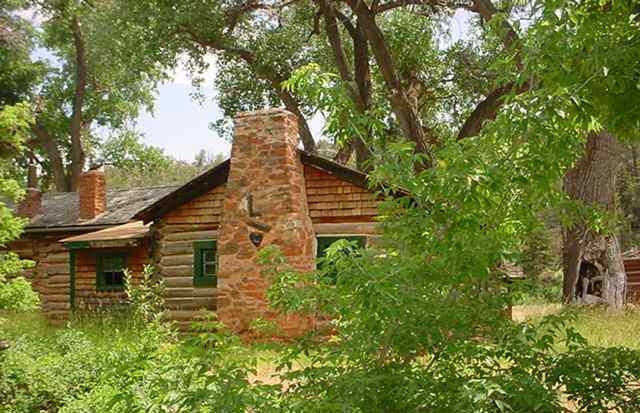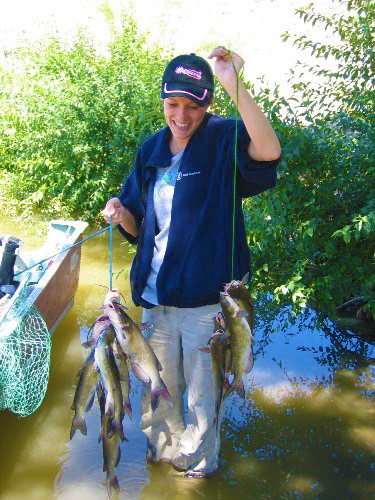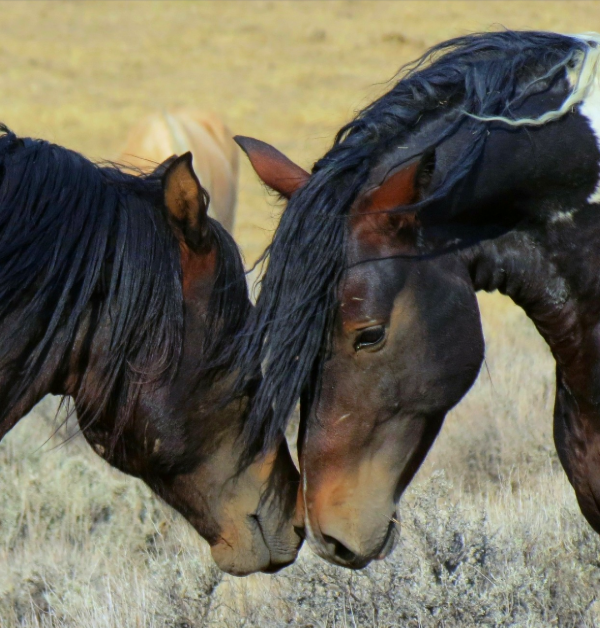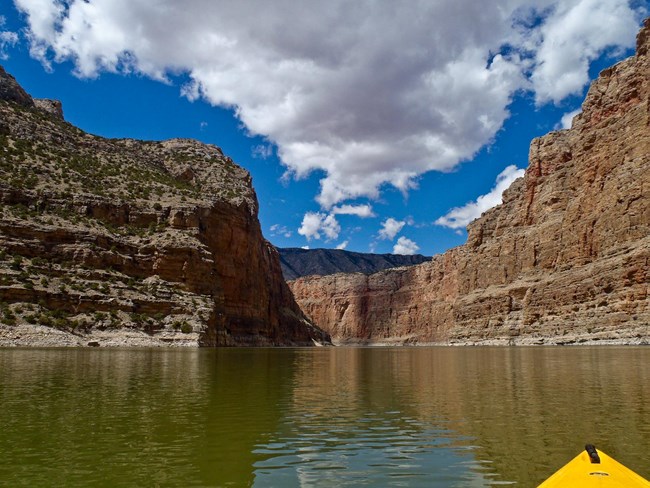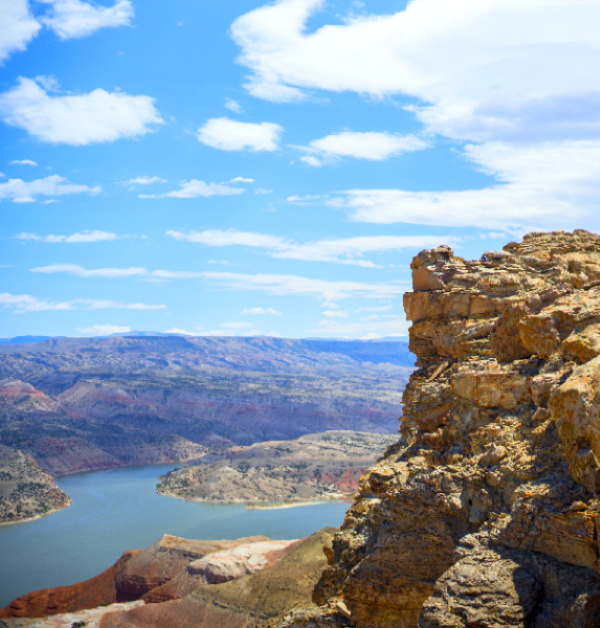- Home Page
- RVing Tips & Tricks
- Bighorn Canyon
5 Unforgettable RVing Activities at Bighorn Canyon
Come along with me and I’ll tell you about 5 unforgettable experiences you can have on your next RV road trip to the Bighorn Canyon in Montana and Wyoming
By: Harry Vanderhoof
The bright red and orange towers of layered sandstone and shale towered above me like Thor’s celestial home in the Castle of Asgard. I sat in meditative silence until slowly, my mind’s-eye began envisioning trails of indigenous peoples migrating from their cave homes in the south tower walls, to their traditional hunting grounds in the north of their vast homeland, stalking Woodland Muskox and Mammoths some 18,000 years ago.
Eventually, the diamond-studded sunlight danced on the river waters below so brightly, I slowly awoke to my present reality. I extended my hands to either side of me touching the cold earth of Montana and I realized once again, that I was on my trout fishing expedition deep in the Bighorn Canyon.
Spanning the borders between Montana and Wyoming lays Bighorn Canyon National Recreation Area, a park with 120,000 acres of historic, pristine land that has plenty to explore. Because of its size and that it inhabits land in two states; the park is split up into two districts; North and South Districts.
This park has diverse wildlife and geographical features, making it a great RVing travel destination any time of the year. With so much to explore and do, be sure to add Bighorn Canyon to your list of sites to visit in your RV.
While there are certainly more than 5 things to do and there are activities and sites you can see that would be enough just for one visit to the park on their own, we are going to go over 5 unforgettable RVing activities at Bighorn Canyon.
Ranches
Visiting Bighorn Canyon is like traveling back in time, and there are four ranches located throughout the park that transport you to the turn of the 1900s when these ranches were established.
Each ranch was set up for a different reason, whether it was to escape bustling city life, start life anew, and raise cattle in a soon-to-be-dying industry, or as an attraction for city dwellers to get an idea for life in the Wild West.
Lockhart Ranch was set up in 1926 when Caroline Lockhart bought 6,034-acres, creating a prosperous farm of lush green, which stood out among the dry landscape. Visit Lockhart Ranch and you’ll wish you could have lived with Caroline as she tended to the ranch for 30 years.
ML Ranch was a cattle operation set up by Henry Lovell and Anthony Mason. Visiting this ranch, you can admire the wide landscape as it stretches as further than the eye can see; imagine Henry and his gang of ranchers waking before sunrise, herding their cattle up to the shipping point at Billings, Montana as dawn approached. The cattle may be gone, but you can still sense their presence as you place yourself in Lovell’s spurred boots.
Simply known as Hillsboro, the third ranch is a dude ranch established by Grosvenor W. Barry (Doc Barry), a serial entrepreneur who had attempted to dig in the dying embers that was the gold mining industry on three separate occasions. Finally giving up his search for the motherlode in 1903, he decided to start a dude ranch in southern Montana where city folk could discover what life was like in the 1800s and get in touch with nature.
The Ewing-Snell Ranch was established near the turn of the 19th century, after the search for gold in the area had been exhausted. Erastus T. Ewing set up the ranch, which after some time became a post office for the area before it was moved in 1906. The Snell family ended up purchasing the ranch in 1920; the ranch is named after both the man who established the ranch
While Ms. Lockhart is no longer around to tell you stories of her years on the ranch and Henry Lovell’s cattle ranching tales are largely lost to time, just admiring the ranches and walking their grounds can transport you back to previous centuries.
Fishing (especially for trout)
Visitors can fish on Bighorn Lake and Bighorn River, which has some of the best trout fishing in the entire nation. As you can image, there is a catch and release requirement, and it is important to remember to remove barbs from all large hooks you use while fishing.
If you are fishing along the Bighorn River, get ready to be distracted by the astounding beauty of the towering bluffs and terrain. Since there are 38 different species of fish that swim up and down the extensive river, you may find a different type of fish dangling from your hook each time you reel in, something many people throughout time have done for centuries.
Bighorn Lake offers plenty of fishing and boating activities as well, including excellent carp and trout fishing opportunities. As the sun rises over the distant horizon, make your way onto the lake or its shoreline and take advantage of one of the best fishing spots in the United States.
Wild Horse Watching
Bighorn Canyon offers visitors the chance to enjoy wildlife that is native to the region and cannot be found elsewhere in the world, such as the largest herd of wild horses in the US.
Viewing the wild horses is absolutely breathtaking, and instantly takes you back to when massive herds roamed throughout the West. These “wild” horses are actually feral horses; they are wild, but are descendants of domesticated horses, such as Spanish, Arabian, and English breeds.
Many of the wild horses in the Pryor Mountain Wild Horse Range have Spanish features, which stand out among domesticated horses we see today. In 1968, 31,000 acres were set aside to allow these herds to roam freely, preserving one of the few remaining features of western Americana. Horses were brought to the Americas from Europe, and transformed the lives of indigenous people; then quickly spread throughout the West, with many millions of wild horses roaming the Great Plains, just south of the Pryor Mountains that now act as home to the massive herds.
One of the best locations to view these herds is along the park road near Crooked Creek and Mustang Flats. Be sure to bring some binoculars!
Boating
Save 50% Off of Campsites with Passport America
Boating on Bighorn Lake is an excellent way to view the park and explore the nooks and crannies of Bighorn Canyon, which surrounds the lake. Floating around on a kayak or exploring various beaches and inlets in your boat allows you have some fun in the sun in a unique environment.
View the exposed Madison Limestone that makes up the canyon’s walls; formed over 300 million years ago, you can occasionally spot ancient seashells embedded in the rock. Bighorn Canyon is an extremely ancient geographic feature, and exploring the waters of Bighorn Lake acts as a lesson in ancient history. Let your mind wander to ancient times as you float about and let the warmth of the sun wash over you.
Hiking
There are many trails to hike in Bighorn Canyon, but we will go over three hikes that you don’t want to miss out on during your visit to the park. These trails offer unforgettable views and great opportunities for seeing the local wildlife, not to mention some decent exercise.
First up is Beaver Pond Nature Trail, a 2.6 mile roundtrip hike. It is a pretty easy hike that allows you to see a beaver habitat at Lime Kiln Creek, full of gnawed trees and various materials beavers use to construct their homes, a site you don’t normally see at most parks.
If you don’t have a fishing pole or aren’t accustomed to fly fishing, you can view others casting their reels in the Bighorn River as you walk the Three Mile Access Trail. Despite its name, this hike is only 2 miles round trip, an easy walk to stretch your legs after a long day RVing on the road. The trail ends near the riverbank in a grove of cottonwood trees that provide cover from the sun and wind as you admire the flowing waters.
The Sykes Mountain Trail is the longest and toughest hike of the three listed here, as it is 4.6 mile roundtrip and includes an elevation gain of 1,380 feet. You are tasked with ascending a rough desert mountain trail, which sounds intimidating, but it is a favorite trail among the more advanced hikers in the park. Once you reach the top of the trail at Crooked Creek Summit, you can view the landscape for many miles in every direction, admiring the mountains that guard the Bighorn Basin.
Bighorn Canyon Recreational Area offers a unique RVing experience you don’t get to enjoy at other parks around the country. The next time you plan an RV trip to the Montana/Wyoming area, be sure to set some time to exploring the wonders of Bighorn Canyon.
About The Author

Harry Vanderhoof loves hiking, outdoors and writing about his adventures. When he’s not helping to connect RV renters to amazing RV Parks or to private RV owners on RV Rental Connection, he can be found blogging for the RV Rental Connection Adventure Blog
Do you have any suggestions or comments on this topic? You can add them to this page by using the comments section located below.
